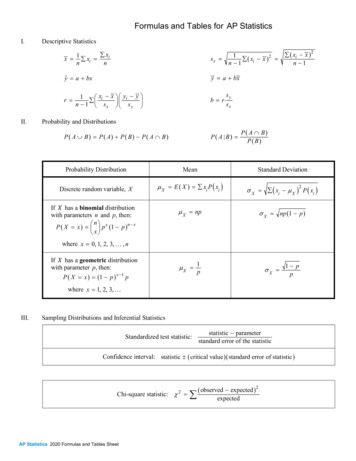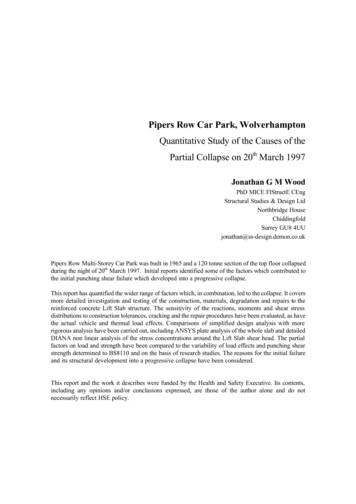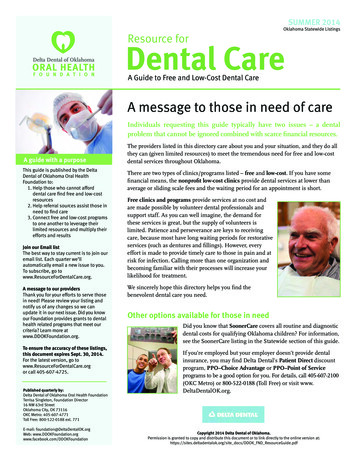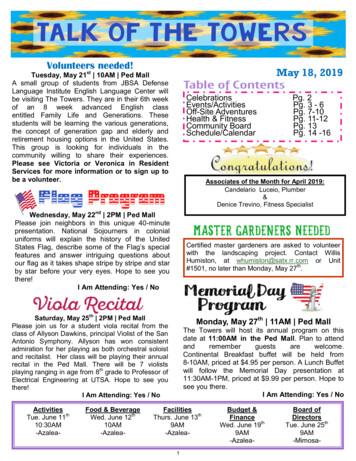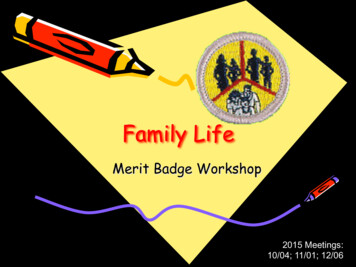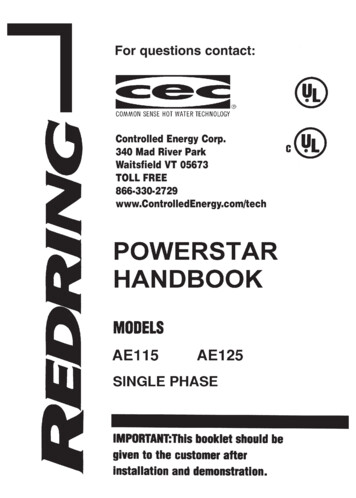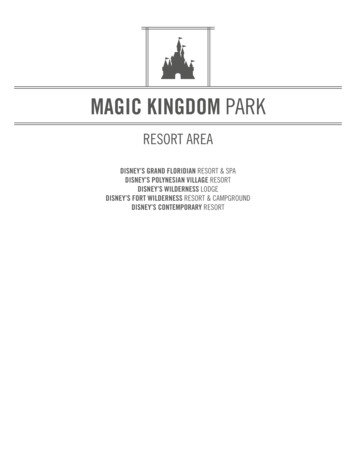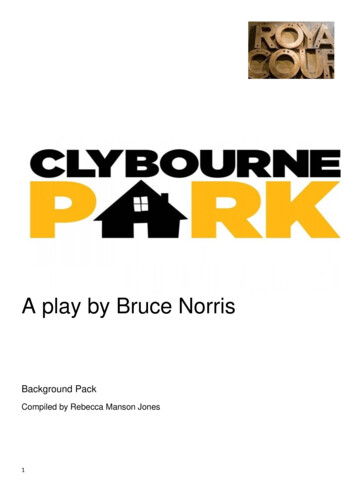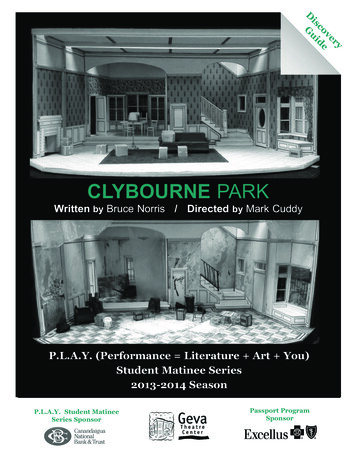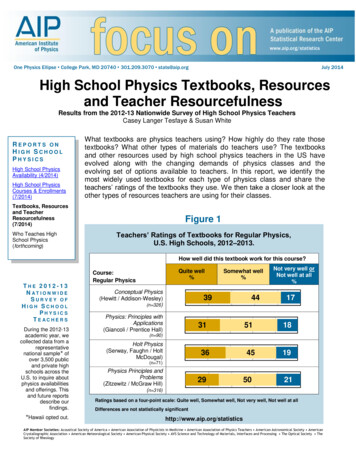
Transcription
www.aip.org/statisticsOne Physics Ellipse College Park, MD 20740 301.209.3070 stats@aip.orgJuly 2014High School Physics Textbooks, Resourcesand Teacher ResourcefulnessResults from the 2012-13 Nationwide Survey of High School Physics TeachersCasey Langer Tesfaye & Susan WhiteREPORTS ONHIGH SCHOOLPHYSICSHigh School PhysicsAvailability (4/2014)High School PhysicsCourses & Enrollments(7/2014)What textbooks are physics teachers using? How highly do they rate thosetextbooks? What other types of materials do teachers use? The textbooksand other resources used by high school physics teachers in the US haveevolved along with the changing demands of physics classes and theevolving set of options available to teachers. In this report, we identify themost widely used textbooks for each type of physics class and share theteachers’ ratings of the textbooks they use. We then take a closer look at theother types of resources teachers are using for their classes.Textbooks, Resourcesand TeacherResourcefulness(7/2014)Who Teaches HighSchool Physics(forthcoming)Figure 1Teachers’ Ratings of Textbooks for Regular Physics,U.S. High Schools, 2012–2013.How well did this textbook work for this course?Quite well%Course:Regular PhysicsTHE 2012-13N AT IONW IDESURVEY OFHIGH SCHOOLPHYSICSTEACHERSDuring the 2012-13academic year, wecollected data from arepresentativenational sample ofover 3,500 publicand private highschools across theU.S. to inquire aboutphysics availabilitiesand offerings. Thisand future reportsdescribe ourfindings. Hawaii opted out.Conceptual Physics(Hewitt / Addison-Wesley)(n 326)Somewhat well%39Physics: Principles withApplications(Giancoli / Prentice Hall)314451Not very well orNot well at all%1718(n 90)Holt Physics(Serway, Faughn / HoltMcDougal)364519(n 71)Physics Principles andProblems(Zitzewitz / McGraw Hill)(n 316)295021Ratings based on a four-point scale: Quite well, Somewhat well, Not very well, Not well at allDifferences are not statistically significanthttp://www.aip.org/statisticsAIP Member Societies: Acoustical Society of America American Association of Physicists in Medicine American Association of Physics Teachers American Astronomical Society AmericanCrystallographic Association American Meteorological Society American Physical Society AVS Science and Technology of Materials, Interfaces and Processing The Optical Society TheSociety of Rheology
Page 2focus on HS Physics Textbooks, Resources and Teacher ResourcefulnessTable 1Most Widely Used Physics Textbooks for Regular Physics,U.S. High Schools, 1987-2013.Percent of Regular Physics Teachers Using Text2013 2009 2005 2001 1997 1993 1990 1987“It’s hard to find atextbook for ‘regular’physics.” – PhysicsTeacherHolt Physics(Serway, Faughn, HoltMcDougal)Conceptual Physics(Hewitt / Addison-Wesley)Physics Principles andProblems(Zitzewitz / McGraw Hill)Physics: Principles withApplications(Giancoli / Prentice %32%40%49%53%44%42%33%7%6%5%---------------Based on 1213 teachers of Regular Physics in public and private high schools in the U.S.* Less than 5%--- Not separately ratedhttp://www.aip.org/statisticsRegular PhysicsPhysics Principles and Problems (Zitzewitz) has been the most widely usedtextbook since we started tracking textbook use in regular physics classesin 1987 (Table 1). In recent years however Holt Physics (Serway et al.) andConceptual Physics (Hewitt) have gained popularity and may now be morewidely used than the Zitzewitz text. A smaller, but steady proportion ofteachers use Physics Principles with Applications (Giancoli). Of these threedominant regular physics texts, none was rated significantly higher or lowerthan the others (Figure 1, front page). About four-fifths of teachersreported that the textbook they used worked quite or somewhat well fortheir classes, and the other-fifth reported that the textbook they used didn’twork very well or didn’t work at all.Regular physics classes can include a wide variety of students withdifferent levels of preparation. As one teacher explained: “I struggle withfinding the right level of text complexity and problem set.” Many teachersaddress the challenges of their particular classes with other materials thatthey use either in addition to their textbooks or altogether in place of a classtextbook. These materials are discussed in greater depth later in this report.July 2014AIP Statistical Research Center
focus on HS Physics Textbooks, Resources and Teacher ResourcefulnessPage 3Conceptual PhysicsAs you can see in Table 2, the most widely used book for ConceptualPhysics courses is Conceptual Physics (Hewitt). Conceptual Physics(Hewitt) is used by 73% of Conceptual Physics classes. Three othertextbooks are also common, although they are much less widely used.These include: Holt Physics (Serway, Faughn), Physics Principles andProblems (Zitzewitz) and Active Physics, It’s About Time (Eisenkraft).There is quite a variety to high school physics classes, and textbooks workbetter for some courses than others. Although the Hewitt book worked wellfor Regular Physics courses (Figure 1), it worked better for ConceptualPhysics courses (Figure 2). Of the teachers using Hewitt, almost halfreported that it worked quite well for their classes, and nearly 90% reportedthat it worked either somewhat or quite well for their classes. There werenot enough teachers reviewing any of the other textbooks to report reliably.Although the math in Conceptual Physics is less advanced than the math inRegular Physics, teachers still have to adjust to the preparation level of thestudents in their classes. Some teachers needed to add math to theirTable 2Most Widely Used Physics Textbooks for Conceptual Physics,U.S. High Schools, 1987-2013.Percent of Conceptual Physics Teachers Using Text2013 2009 2005 2001 1997 1993 1990 1987Course:Physics First*Conceptual Physics(Hewitt / Addison-Wesley) 53% 74%------------Conceptual Physics or Physics for Non-Science StudentsConceptual Physics(Hewitt / Addison-Wesley) 73% 80% 76% 75% 74% 79% 75% 27%Holt Physics(Serway, Faughn / HoltMcDouglas) 9%5%------------Physics Principles andProblems(Zitzewitz / McGraw Hill)5%7%*6%7%8%7%28%“The book used in thegeneral class is toobasic and the bookused in my AP classassumes a level ofbackground knowledgethat my students lack.”– Physics TeacherBased on 200 teachers of Conceptual Physics and 93 teachers of Physics First in publicand private high schools in the U.S.--- Physics First was explicitly included in the list of courses for the first time on the 2008-09survey* Less than 5%http://www.aip.org/statisticsAIP Statistical Research CenterJuly 2014
Page 4focus on HS Physics Textbooks, Resources and Teacher ResourcefulnessFigure 2Teachers’ Ratings of Textbooks for Conceptual PhysicsU.S. High Schools, 2012-2013.“I like Hewitt’s booksbecause I can add in asmuch math as my kidscan handle and theconcepts are explainedvery well. It is by farthe very best physicsprogram” – PhysicsTeacherHow well did this textbook work for this course?Not very well orQuite wellSomewhat wellNot well at all%%%Course:Physics FirstConceptual Physics(Hewitt / Addison-Wesley)434983913(n 49)Physics for Non-Science Studentsor Conceptual PhysicsConceptual Physics(Hewitt / Addison-Wesley)48(n 145)Ratings based on a four-point scale: Quite well, Somewhat well, Not very well, Not well at allDifferences are not statistically significanthttp://www.aip.org/statisticscourses, and others needed less math. The Conceptual Physics teachersresponded positively to Hewitt, but they are also addressing thesechallenges by integrating other types of materials into their classes. Oneteacher described the way they used the text: “We are not textbook based.We have a classroom set of Hewitt, but students do not take a book home.”Another teacher said, “While I pull material from many many textbooks andonline sources, I generally make my own note sheets, my own assesments,and my own practice [classwork / homework] to most appropriately addressthe ability level, interest, and time restrictions of my classes.”Physics FirstPhysics First is a type of conceptual physics class in which physics isoffered first in the sequence of high school science courses. ConceptualPhysics (Hewitt) is used by 74% of the Physics First teachers (Table 2), andthe teachers rate it very highly (Figure 2). Foundations of Physics (Hsu)and Physics Principles and Problems (Zitzewitz) are less widely used forPhysics First classes.July 2014AIP Statistical Research Center
focus on HS Physics Textbooks, Resources and Teacher ResourcefulnessPhysics First teachers sometimes encounter challenges trying toaccommodate differing sets of standards, and these challenges can beaddressed by adding supplemental resources to the curriculum. Oneteacher integrates other resources into their class because she "found thattextbooks don't match up with simultaneously doing Physics First andcurrent California State Standards."First Year Honors, Accelerated, or Gifted and Talented PhysicsHolt Physics (Serway et al.) continues to be the most widely used book forHonors physics (Table 3). About a third of Honors teachers use it. PhysicsPrinciples and Problems (Zitzewitz) and Physics: Principles withApplications (Giancoli) are also commonly used by teachers of Honorsphysics.Table 3Most Widely Used Textbooks for First Year Honors andAccelerated, or Gifted and Talented Physics,U.S. High Schools, 1987–2013.Percent of Honors Physics Teachers Using Text2013 2009 2005 2001 1997 1993 1990 1987Holt Physics(Serway, Faughn, HoltMcDougal)Physics: Principles withApplications(Giancoli / Prentice Hall)Physics Principles andProblems(Zitzewitz / McGraw Hill)Conceptual Physics(Hewitt / Addison-Wesley)College Physics(Serway, Faughn, Vuille /Brooks / -Based on 445 teachers of Honors Physics in public and private high schools in the U.S.* Less than 5%--- Not separately ratedhttp://www.aip.org/statisticsAIP Statistical Research CenterJuly 2014Page 5
Page 6focus on HS Physics Textbooks, Resources and Teacher ResourcefulnessFigure 3Teachers’ Ratings of Textbooks for First Year Honors,Accelerated, or Gifted and Talented Physics,U.S. High Schools, 1987–2013.How well did this textbook work for this course?Quite well%“I supplement eachcourse with materialsfrom the book for theother course. Thishelps me emphasizeconcepts for theHonors andmathematicallychallenge the Regular”– Physics TeacherCourse:First Year Honors, Accelerated, orGifted and Talented PhysicsPhysics: Principleswith Applications(Giancoli / PrenticeHall)Not very well orNot well at all%Somewhat well%56386(n 84)College Physics(Serway, Faughn,Vuille / Brooks /Cole)(n 25)Holt Physics(Serway, Faughn,Holt McDougal)48391345478(n 145)Conceptual Physics(Hewitt / AddisonWesley)304921(n 47)Ratings based on a 4 point scale: Quite well, Somewhat well, Not very well, Not well at all* Giancoli’s text rated significantly higher, and Hewitt’s text rated significantly lower than theother texts listed. Other differences were not statistically significant.http://www.aip.org/statistics“We are shifting to ipadinstruction, and theZitzewitz textbook isavailable ” – PhysicsTeacherJuly 2014Giancoli’s text was very highly rated (Figure 3). Not only did 56% of teacherssay that this textbook worked quite well for their courses, only a smallpercentage (6%) said that it worked not very well or not well at all. Two morebooks, College Physics (Serway et al.) and Holt Physics (Serway, Faughn)were quite highly rated by the teachers who used them. Conceptual Physics(Hewitt) was not rated as highly for Honors Physics classes, as it appeared tobe better suited for Conceptual and Regular Physics classes.Many teachers, including those who rated their textbooks highly, said that theyhave integrated more supplemental materials, some of which were part of theirtextbook packages or e-texts, into their curriculum. One teacher reported:“Giancoli has excellent PowerPoints, clickers and test resources.”AIP Statistical Research Center
focus on HS Physics Textbooks, Resources and Teacher ResourcefulnessAdvanced Placement ClassesAdvanced Placement Physics classes rose in prevalence andprominence in the 1990s. AP Physics B is an introductory course thatrelies on algebra and trigonometry, and AP Physics C relies heavilyon calculus. The two most widely used textbooks for AP Physics Bcontinue to be Physics: Principles with Applications (Giancoli) andCollege Physics (Serway et al.) (Table 4). AP Physics teachers ratedboth books quite highly, although Giancoli rated particularly high(Figure 4).AP Physics C texts focus on solutions to challenging problems in bothmechanics, and electricity and magnetism. The most widely used textfor AP Physics C was Fundamentals of Physics (Halliday et al.).Physics for Scientists & Engineers (Serway et al.), Physics forScientists & Engineers (Tipler, Mosca) were also commonly used.Table 4Most Widely Used Textbooks for Advanced Placement PhysicsClasses, U.S. High Schools, 1987-2013.Percent of AP Physics Teachers UsingText201320092005200119971993Physics: Principles with Applications(Giancoli / Prentice Hall)37%36%35%33%27%28%College Physics(Serway, Faughn, Vuille / Brooks /Cole)24%26%20%25%24%10%College Physics(Wilson, Buffa, Lou / Prentice Hall)6%6%------------Physics(Walker / Pearson)10%6%------------Fundamentals of Physics (Halliday,Resnick, Walker / Wiley)36%7%45%47%41%39%Physics for Scientists & Engineers(Serway, Jewett / Cengage Learning)15%19%------------Physics for Scientists & Engineers(Tipler, Mosca / WH Freeman)14%---------------Course:Advanced Placement Physics BAdvanced Placement Physics CBased on 382 teachers of AP B and 202 teachers of AP C Physics classes in publicand private high schools in the U.S.* Less than 5%--- Not separately ratedhttp://www.aip.org/statisticsAIP Statistical Research CenterJuly 2014Page 7
Page 8focus on HS Physics Textbooks, Resources and Teacher ResourcefulnessFigure 4Teachers’ Ratings of Textbooks for Advanced Placement Physics,U.S. High Schools, 2012–2013.How well did this textbook work for this course?Not very well orQuite wellSomewhat wellNot well at all%%Course:%Advanced Placement Physics BPhysics: Principles withApplications (Giancoli /Prentice Hall)58366(n 138)Textbooks for APPhysics classes tendto be rated quite wellby the teachers whouse them.College Physics(Serway, Faughn, Vuille/ Brooks / Cole)47449(n 90)Physics (Walker /Pearson)5542354424(n 38)College Physics(Wilson, Buffa, Lou /Prentice Hall)(n 24)Advanced Placement Physics CFundamentals ofPhysics (Halliday,Resnick, Walker /Wiley)Physics for Scientists &Engineers (Serway,Jewett / CengageLearning)673371263(n 31)Physics for Scientists &Engineers (Tipler,Mosca / WH Freeman)523117(n 29)Ratings based on a four-point scale: Quite well, Somewhat well, Not very well, Not well at all* Differences for texts within each type of physics class are not statistically significanthttp://www.aip.org/statisticsJuly 2014AIP Statistical Research Center
Page 9focus on HS Physics Textbooks, Resources and Teacher ResourcefulnessA Closer Look at Textbooks and Resources inthe Modern Physics ClassroomWe have been asking teachers for decades about the books they use for theirclasses, but this is the first year that we were also able to gain a morenuanced understanding of how teachers use their textbooks. We asked theteachers about the resources they use to supplement their classes, and to oursurprise, many teachers, including teachers who rated their books highly, toldus that they use their textbooks as one of many classroom resources, or theysimply keep the books in the classroom as a reference, or they don’t use atextbook at all for their classes.In this section we describe the resources teachers use and how they integratethem into their curricula. Teachers demonstrate quite a bit of initiative,creativity and resourcefulness. Instead of simply using the texts that aresupplied to them, they use a wide variety of resources in order to create acurriculum that works well with the needs of their students and therequirements of their schools.Teachersdemonstrate quite abit of initiative,creativity andresourcefulnessWe will hear directly from the teachers about the textbooks and resourcesthey use for their classes. The resources we list and comments that we willshare in this section are taken directly from the verbatim responses to twoopen ended questions that were side by side in the questionnaire. Theseresponses have been minimally processed (spelling corrections only).Figure 5Open Ended Questions about Physics Textbooks in Teacher Survey,U.S. High Schools, 2012–2013.“As a profession weneed to think verycarefully about howto educate amodern student inthis material” –Physics Teacherhttp://www.aip.org/statisticsAIP Statistical Research Centerhttp://www.aip.org/statisticsJuly 2014
Page 10focus on HS Physics Textbooks, Resources and Teacher ResourcefulnessWhy not simply rely on the textbooks?“The supplementalHolt Physicstextbook is from1999 and we borrowit from aneighboringschool” – PhysicsTeacherTeachers must take into account a wide variety of factors while planningand teaching their classes. Not only is every student different, but eachclass is different. In addition to the challenges of the classroom, teachersface sets of standards set by their schools, districts and states. Thediversity of their challenges reflects the tremendous variance in preparationamong the physics students and the lack of standardization amonglegislative goals in the US. The challenges that teachers face inaccommodating curricular and student needs inspire them to thinkcreatively and strategically about curriculum.One common obstacle that teachers cited in working with textbooks wasfunding. Schools have limited funds, and they are often forced to makedifficult decisions about the allocation of those funds. As one teacherexplained: “In cash strapped education, textbooks are a luxury. We wentwith department computers over textbooks last curriculum cycle.” The lackof funding meant that some schools were unable to issue textbooks to eachstudent, some schools shared textbooks with neighboring schools, andsome schools were altogether unlikely to purchase replacements for out-ofdate texts. Given tightening school budgets and the students’ engagementwith digital and online media, we may see an increase in the variety ofteaching resources used in physics classes.In some cases teachers relied less on textbooks not because of the booksthemselves, but because of the mindset of the students. One teacherexplained that “While I really liked the textbooks for both my classes, thestudents rarely used them.”July 2014AIP Statistical Research Center
Page 11focus on HS Physics Textbooks, Resources and Teacher ResourcefulnessAdvantages of Online ResourcesAdjusting the level of math or the number of demonstrations in a course is notnew to teachers, but the vast array of high quality resources is. Teachers aredrawing from a wide variety of materials and resources in conjunction with thetraditional textbooks, and sometimes in place of traditional textbooks. Manyhave decided to use online or interactive curriculum materials, and some havecurated their own set or resources or use other curated resources.Teachers used these supplemental resources in a variety of ways. Some usedcomprehensive online courses or assembled their own resources using onlinetools- a very popular example of which is a class management system calledMoodle.(1) Some used supplemental materials to target specific problems orchallenges, and some used them to guide or even “flip” their classroomsasking their students to watch lectures at home and come to class withquestions, ready to do homework problems together.Adjusting the levelof math or thenumber ofdemonstrations in acourse is not new toteachers, but thevast array of highquality resources is.In some cases, online resources were a way of accommodating students whoare increasingly well versed in the digital world.Teachers used online resources in response to changes in studentexpectations.In their own words "For the style of learning and level of my students, I found that supplementalInternet materials worked best.""My students prefer the Internet resources to the textbook 99% of the time."http://www.aip.org/statisticsThe Resources Teachers UseSome of the online materials for physics courses are quite comprehensive,including everything from video demonstrations, labs and lectures to practiceproblems and lesson plans. Teachers find these comprehensive coursematerials in a wide variety of places online. What follows below is a listing andexploration of the materials that teachers reported using.AIP Statistical Research CenterJuly 2014
Page 12focus on HS Physics Textbooks, Resources and Teacher ResourcefulnessComprehensive Class ResourcesClassroom Materials Used by High School Physics Teachers in the U.S.,2012-2013 Academic Year:ComPADREhttp://www.compadre.org/The Physics Classroom (including Minds on Physics)http://www.physicsclassroom.com/Modeling Physicshttp://modelinginstruction.org/MIT Physics d- How Things Workhttp://www.howeverythingworks.org/Cinch O 19/Default.aspxDolores Gendehttp://www.dgende.net/Energizing t and Matterhttp://www.lightandmatter.com/Mastering thamerica/masteringphysics/Physics in Context- Cord ore/Contextual Science/Physics in Context.aspPhysics Union Mathematicshttp://pum.rutgers.edu/Sapling ip.org/statisticsJuly 2014AIP Statistical Research Center
focus on HS Physics Textbooks, Resources and Teacher ResourcefulnessNot all of the online resources that teachers used for their classes werecomprehensive. A few teachers reported that they were taking advantage of thetutorials on the Khan Academy website.(2) One of these teachers is using the KhanAcademy tutorials to “flip” their class: “I've been ‘flipping’ class. The students watchassigned Khan Academy videos and then come to class with questions.” All of thecomprehensive resources listed on the previous page have lectures and tutorials, butthe Khan Academy and other websites, such as the Perimeter Institute (3) andSEPUP(4) have only the lectures and tutorials.Another teacher cited a big obstacle to textbook problems: "ALL questions/problemsin physics books have the answers posted on the internet. All you have to do is totype the question into Google and the rest pops up from somewhere. Many teachersfound problems on the comprehensive sites we listed, but others found problems attesting sites and sites like the CAPA website.(5)One teacher used new hybrid cite that was built by a major publishing house, an ebook called WileyPlus,(6) and another teacher purchased materials from a Physicsspecific online vendor called Science Joy Wagon. (7)Some teachers used resources, including those listed below,demonstrations, simulations and labs to bring physics teachings to life.forvideoVideo Demonstrations, Simulations and LabsClassroom Materials Used by High School Physics Teachers in the U.S.,2012-2013 Academic Year:Real Time sics/SloMo Guys on hET Interactive .pbs.org/wgbh/nova/physics/Bill Nye eorgia Public tatisticsAIP Statistical Research CenterJuly 2014Page 13
Page 14focus on HS Physics Textbooks, Resources and Teacher ResourcefulnessTeachers used online resources to meet specific standards for their states, includingtests like the New York State regents(8) tests, for which teachers collected practiceproblems from past exams. Some teachers reported local resources that host teachertraining events, such as The Science House in North Carolina. (9) Other resources, suchas the Ohio Modeling Materials site(10) and Texas C-Scope(11) echoed wider learninginitiatives but focused them in more local, state-based ways. The New Jersey Centerfor Teaching and Learning(12) offers professional development classes for teachers aswell as course-specific materials.Some of the teachers did not list specific on-line resources, but did share other types ofcreative strategies that they employ in their classes. A selection of those strategies islisted below:Class Materials not Found OnlineUsed by High School Physics Teachers in the U.S.,2012-2013 Academic Year:In their own words "Much of the material I use I have developed myself."“I am working on creating my own textbook, videos, and resource material for mystudents. I am designing a program to fit all the different learner types I'll do theprogramming myself and distribute it to my students as a point and click executable file.”"We use teacher generated videos.""Some of the best text I've read is actually in the old Project Physics text, which I stillhave a class set of.""I supplement with material from college level courses and industry experience."“I supplement with construction projects (kites, hot air balloon, roller coasters, towers,and circuits).”"I used many other sources for my students, such as writings by David Bodanis, Internet,Discover magazine, Science Illustrated magazine, TOPS, and projects from otherteachers."“I incorporate published findings from magazines and websites to further the material inthe text and give it a more data oriented focus.”“I have materials from the last 15 years of teaching physics that I use.”http://www.aip.org/statisticsJuly 2014AIP Statistical Research Center
focus on HS Physics Textbooks, Resources and Teacher ResourcefulnessA few teachers took the liberty of dreaming up the future of educationalresources. One teacher mused: “I am constantly adding practice problems[.]I would give my eye teeth for a book that combines the conceptual and mathbased approaches as well as includes inquiry based learning.” Anotherteacher summed up the wishes of many: “I need a responsive onlinehomework system that adjusts the level of difficulty and provides hints asrequired according to the student responses.” This and many other visions offuture class materials may be a reality when we next report on the textbooksand resources used in physics classrooms!Footnotes:(1) Moodle: http://www.moodle.org(2) Khan Academy: https://www.khanacademy.org/science/physics(3) Perimeter Institute: http://perimeterscholars.org(4) SEPUP: http://sepuplhs.org/index.html(5) CAPA: http://webwork.maa.org/wiki/CAPA Physics Problems#.U494dPldUsc(6) WileyPlus: .html(7) Science Joy Wagon: http://www.sciencejoywagon.com/physicszone(8) New York State Regents: http://www.nysedregents.org/physics(9) The Science House: http://www.thesciencehouse.org(10) Ohio State Modeling Materials: demic-contentstandards/science/hsscience model curriculum april2014.pdf.aspx(11) Texas C-Scope: http://www.tcmpc.org(12) New Jersey Center for Teaching and Learning: https://njctl.orgAIP Statistical Research CenterJuly 2014Page 15
Page 16focus on HS Physics Textbooks, Resources and Teacher ResourcefulnessSurvey MethodologyThis study is based on a sample of one-sixth of the public and private high schools in theU.S. Data collection for this round began in the fall of 2012. Although in past years webegan the study by surveying all of the schools in our sample, we changed our methodologythis round in order to lower the burden on high schools in our sample, many of which arealready heavily surveyed. We began with web searches for each of the 3,858 schools in oursample. If we could identify a physics teacher at the school, we collected the contactinformation for that teacher. If not, we collected contact information for the principal orscience chair. We then contacted each of the schools where we had not identified a physicsteacher by phone and e-mail to determine whether or not physics was offered at the schooland, if so, who taught it. We collected data on whether or not physics was offered from3,553 of our 3,858 sampled schools (92%). We compared demographics for the nonresponding schools with those of the responding schools and found no evidence to suggestthat the two groups differedsignificantly. Thus, we believe we have a representativesample of schools.During the spring of 2013, we contacted each of the 3,702 teachers we had identified in thefall to learn more about physics in each of the high schools. We heard back from 56% of theteachers.Without the help of the principals, teachers, and staff at our sampled schools, we could notprovide this information. We offer a sincere thanks to each of you.Physics in Hawaiian High SchoolsFor the first time in the history of our study, the Superintendent of Schools for the State ofHawaii refused to allow us to contact schools in Hawaii. Thus, the data in this report coversall high schools – both public and private – in every state in the U.S. except Hawaii. Hawaiipublic schools account for less than one-half of one percent ( 0.5%) of seniors enrolled inall U.S. public schools; likewise, schools in Hawaii account for less than one p
Physics Principles and Problems (Zitzewitz) has been the most widely used textbook since we started tracking textbook use in regular physics classes in 1987 (Table 1). In recent years however Holt Physics (Serway et al.) and Conceptual Physics (Hewitt) have gained popularity
